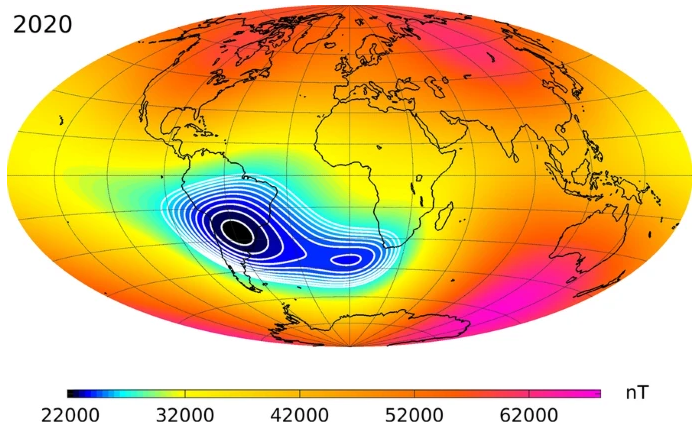The South Atlantic Anomaly (SAA) is a phenomenon in which satellites and spacecraft flying over the South Atlantic region are exposed to an increased level of charged particles, which can damage them.
The SAA region is the region where the inner Van Allen belt is closest to Earth, only 190 km from its surface precisely. At this altitude, spacecraft in low Earth orbit (LEO) may periodically pass through the SAA. Exposing them (and in the case of manned flights, their passengers) to large amounts of trapped high-energy particles—that is, doses of radiation that could be harmful.
What are Van Allen belts? This region of intense ionizing radiation was discovered in 1958 by American astronomer James Van Allen. There are two areas of this increased radiation in space around the Earth: internal and external. Most of the particles are derived from the so-called “solar wind” (a stream of highly charged particles emitted from the Sun into space) and cosmic rays are repelled from Earth by its magnetic field. However, some of these particles do not “reflect” the Earth’s magnetic field. Instead they are “caught” in regions called the Van Allen radiation belts. Due to the fact that the Earth’s magnetic axis (with respect to the symmetric arrangement of the Van Allen belts) does not exactly coincide with the axis of Earth’s rotation, the distance of these lines from the Earth’s surface varies around the world. The South Atlantic Ocean is at the point where this distance is the shortest, which is why most spacecraft failures occur above this point.
Over the years, the SAA area has been the cause of many spacecraft crashes. It is also taken into account when planning all manned missions, as well as spacewalks for astronauts from the International Space Station (ISS). One of the fairly recent cases where a satellite was completely lost is the one that occurred in March 2016. The Japanese X-ray astronomy satellite, also known as “Hitomi,” had to study X-rays. The Japanese space agency JAXA lost contact with the ship, and shortly after that, the US-led Joint International Space Operations Center issued a message confirming the disintegration of the “Hitomi” satellite into several pieces. The instrument on board Hitomi, which was intended to orient the ship in relation to the stars, does not function properly every time the satellite passes through the SAA area. The most likely cause of the ship’s crash and destruction was the intense radiation in the SAA area, which caused the data aboard Hitomi to misinterpret the data. To correct it, the satellite began to spin, and then began to spin faster and faster around its axis, which eventually disintegrated in orbit.
There are many instances where the SAA region has caused problems and has been around for a long time. In the 1970s, NASA’s Skylab space station, followed by the shuttles, the International Space Station, and most recently, even Elon Musk’s SpaceX Dragon spacecraft, had accidents or other problems as it passed through the anomalous South Atlantic.
Over time, scientists and engineers working for space agencies building spacecraft have gained more experience, reducing the effects of AAS systems. First, if possible, flight paths in low Earth orbit were planned differently. Second, new and advanced semiconductors that have the ability to heal themselves in the event of minor defects have come into use. The appropriate electronic parts are also designed differently by placing them deeper into the spacecraft’s chassis or surrounding it with additional protective layers to protect it from harmful particles. Fortunately, the SAA anomaly is not dangerous to humans, or at least does no harm to astronauts if they are in its area for a brief period, and they pass through it in minutes aboard the International Space Station.

“Music specialist. Pop culture trailblazer. Problem solver. Internet advocate.”







